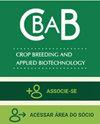Sequencing and gene expression studies for Al tolerance in contrasting genotypes of tropical maize
IF 1.1
4区 农林科学
Q2 Agricultural and Biological Sciences
引用次数: 1
Abstract
: The aims of this study were to evaluate the homology of the ZmMATE1 and ZmMATE2 gene sequences with those deposited in the international banks of sequences and quantify the differential expression of the genes ZmMATE1, ZmMATE2, and ZmNrat1 in germplasms of landrace and hybrid maize under aluminum (Al) stress in minimal solution. Fifty-two hybrids from different companies and 50 landrace varieties were genotyped for the genes ZmMATE1 and ZmMATE2. For studies of gene expression, the tolerant (H 44 and V 18) and the sensitive (H 22 and V 25) genotypes were exposed to minimal solution containing 4 mg L -1 of Al for different periods (0, 1, 3, 6, 9, 12, 24, and 48 h). The results showed greater differential expression in the tolerant V 18 landrace variety of the gene ZmMATE1, indicating that exudation of citrate may be the main mechanism of Al tolerance in this genotype. device and diluted to a concentration of 10 ng mL -1 . The genomic regions surrounding the oligonucleotides that represent the genes ZmMATE1 and ZmMATE2 identified by Maron et al. (2010) were used to detect the presence of amplified fragments through polymerase chain reaction (PCR) in the two maize germplasms studied. The forward primer 5’CCGGATGTTTGCTGGATTTT3’ and the reverse primer 5’TGGCCAAA TCGACCATGATT3’ were used in the respective germplasms for detection of the gene ZmMATE1 . The gene ZmMATE2 was amplified using the pair of the forward primer 5’GCAGTTCGTACGTAGTGGTG3’ and the reverse primer 5’AGTACGTAGCTAGGCGATGC3’.热带玉米耐铝基因型的测序和基因表达研究
本研究的目的是评价ZmMATE1和ZmMATE2基因序列与国际序列库中的同源性,并定量分析ZmMATE1、ZmMATE2和ZmNrat1基因在最小溶液铝胁迫下在地方玉米和杂交玉米种质中的差异表达。对来自不同公司的52个杂交种和50个地方品种进行了ZmMATE1和ZmMATE2基因分型。在基因表达研究中,将耐受性基因型(h44和v18)和敏感性基因型(h22和v25)分别暴露于含有4 mg L -1 Al的微量溶液中不同时间(0、1、3、6、9、12、24和48 H),结果表明耐受性基因ZmMATE1在v18地方品种中表达差异较大,表明柠檬酸盐分泌可能是该基因型耐铝的主要机制。并稀释至10 ng mL -1的浓度。利用Maron等人(2010)鉴定的代表ZmMATE1和ZmMATE2基因的寡核苷酸周围的基因组区域,通过聚合酶链反应(PCR)在研究的两种玉米种质中检测扩增片段的存在。ZmMATE1基因的检测分别采用正引物5’ccggatgtttgctggattttt3’和反向引物5’ggccaaa TCGACCATGATT3’。ZmMATE2基因通过正向引物5'GCAGTTCGTACGTAGTGGTG3 '和反向引物5'AGTACGTAGCTAGGCGATGC3 '进行扩增。
本文章由计算机程序翻译,如有差异,请以英文原文为准。
求助全文
约1分钟内获得全文
求助全文
来源期刊
CiteScore
2.40
自引率
13.30%
发文量
25
审稿时长
6-12 weeks
期刊介绍:
The CBAB – CROP BREEDING AND APPLIED BIOTECHNOLOGY (ISSN 1984-7033) – is the official quarterly journal of the Brazilian Society of Plant Breeding, abbreviated CROP BREED APPL BIOTECHNOL.
It publishes original scientific articles, which contribute to the scientific and technological development of plant breeding and agriculture. Articles should be to do with basic and applied research on improvement of perennial and annual plants, within the fields of genetics, conservation of germplasm, biotechnology, genomics, cytogenetics, experimental statistics, seeds, food quality, biotic and abiotic stress, and correlated areas. The article must be unpublished. Simultaneous submitting to another periodical is ruled out. Authors are held solely responsible for the opinions and ideas expressed, which do not necessarily reflect the view of the Editorial board. However, the Editorial board reserves the right to suggest or ask for any modifications required. The journal adopts the Ithenticate software for identification of plagiarism. Complete or partial reproduction of articles is permitted, provided the source is cited. All content of the journal, except where identified, is licensed under a Creative Commons attribution-type BY. All articles are published free of charge. This is an open access journal.

 求助内容:
求助内容: 应助结果提醒方式:
应助结果提醒方式:


